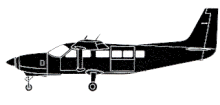Accident description
Last updated: 1 October 2017
| Status: | Final |
| Date: | Friday 11 December 2015 |
| Time: | 09:10 |
| Type: |  Cessna 208B Grand Caravan |
| Operator: | Wasaya Airways |
| Registration: | C-FKDL |
| C/n / msn: | 208B-0240 |
| First flight: | 1990 |
| Total airframe hrs: | 36073 |
| Cycles: | 58324 |
| Engines: | 1 Pratt & Whitney Canada PT6A-114A |
| Crew: | Fatalities: 1 / Occupants: 1 |
| Passengers: | Fatalities: 0 / Occupants: 0 |
| Total: | Fatalities: 1 / Occupants: 1 |
| Airplane damage: | Destroyed |
| Airplane fate: | Written off (damaged beyond repair) |
| Location: | 28 km (17.5 mls) NE of Pickle Lake Airport, ON ( Canada) Canada) |
| Phase: | En route (ENR) |
| Nature: | Cargo |
| Departure airport: | Pickle Lake Airport, ON (YPL/CYPL), Canada |
| Angling Lake/Wapekeka Airport, ON (YAX), Canada | |
| Flightnumber: | 127 |
Wasaya Airways flight 127 (WSG127) was to be the first of three cargo trips in the Cessna 208B Caravan (registration C-FKDL) planned from Pickle Lake Airport, Ontario, Canada to Angling Lake/Wapekeka Airport, Ontario. The first flight was planned to depart at 09:00.
The pilot went to the Wasaya apron and conducted a pre-flight inspection of C-FKDL while a ground crew was loading cargo. The pilot returned to the hangar and received a briefing from the station manager regarding the planned flights. The pilot was advised that the first officer assigned to the flight had been reassigned to other duties in order to increase the aircraft's available payload and load a snowmobile on board.
The pilot completed and signed a Wasaya flight dispatch clearance (FDC) form for WSG127, and filed a copy of it, along with the flight cargo manifests, in the designated location in the company operations room. The FDC for WSG127 showed that the flight was planned to be conducted under visual flight rules (VFR), under company flight-following, at an altitude of 5500 feet above sea level (ASL). Time en route was calculated to be 66 minutes, with fuel consumption of 413 pounds.
The pilot returned to the aircraft on the apron. Loading and fueling were complete, and the pilot conducted a final walk-around inspection of C-FKDL. Before entering the cockpit, the pilot conducted an inspection of the upper wing surface.
At 08:54, the pilot started the engine of C-FKDL and conducted ground checks for several minutes. At 08:58, the pilot advised on the mandatory frequency that WSG127 was taxiing for departure from runway 09.
WSG127 departed from runway 09 at 09:00, and, at 09:01, the pilot reported on the mandatory frequency that the flight was airborne. The flight climbed eastward for several miles and then turned left toward the track to mandatory frequency. At about 3000 feet ASL, WSG127 briefly descended about 100 feet over 10 seconds, and then resumed climbing. At 09:05, the pilot reported that WSG127 was clear of the mandatory frequency zone.
WSG127 intercepted the track to Angling Lake and climbed northward until the flight reached a peak altitude of about 4600 feet ASL at 09:08:41, and then began descending at 09:08:46. At 09:09:16, the flight made a sharp right turn of about 120° as it descended through about 4000 feet ASL. At 09:09:39, the descent ended at about 2800 feet and the aircraft climbed to about 3000 feet ASL before again beginning to descend. At approximately 09:10, WSG127 collided with trees and terrain at an elevation of 1460 feet ASL during daylight hours.
Probable Cause:
Findings as to causes and contributing factors
1. Although the aircraft was prohibited from flying in known or forecast icing conditions, Wasaya Airways Limited Partnership (Wasaya) flight 127 (WSG127) was dispatched into forecast icing conditions.
2. The high take-off weight of WSG127 increased the severity of degraded performance when the flight encountered icing conditions.
3. The pilot of WSG127 continued the flight in icing conditions for about 6 minutes, resulting in progressively degraded performance.
4. WSG127 experienced substantially degraded aircraft performance as a result of ice accumulation, resulting in aerodynamic stall, loss of control, and collision with terrain.
5. The Type C pilot self-dispatch procedures and practices in use at Wasaya at the time of the occurrence did not ensure that operational risk was managed to an acceptable level.
6. Wasaya had not implemented all of the mitigation strategies from its January 2015 risk assessment of Cessna 208B operations in known or forecast icing conditions, and the company remained exposed to some unmitigated hazards that had been identified in the risk assessment.
7. There was a company norm of dispatching Cessna 208B flights into forecast icing conditions, although 4 of Wasaya's 5 Cessna 208B aircraft were prohibited from operating in these conditions.
Accident investigation:




Ingen kommentarer:
Legg inn en kommentar
Merk: Bare medlemmer av denne bloggen kan legge inn en kommentar.